Page
9: Aklavik
Reindeer
Herds
One
thing different about Aklavik was an interesting addition to our customary
northern cuisine. Venison was occasionally available, not from deer,
but in the form of reindeer meat. This delicacy was available after
the Reindeer Station's annual cull of the government herds north of
Aklavik. The last time I had eaten venison was during the war, when
Dick was stationed at Arundel in Sussex. The Duke of Norfolk's deer
herd roamed the park surrounding his family seat, Arundel Castle,
and was regularly culled. Since there was not enough for the meat
to be officially rationed, it could be purchased without sacrificing
food ration coupons, and made a useful addition to our wartime diet.
The
Mackenzie delta's original herd of three thousand reindeer was imported
from Alaska. It took six years, from 1929 to 1935, for them to accomplish
the journey to the 6,600-square-mile reindeer reserve on the east
side of the Mackenzie River, about fifty miles from Aklavik. The government
hoped that the herd would provide not only a source of food for the
natives but also a means of employment. Laplanders were brought over
from Norway to train Inuit who wished to become herders. In 1951 the
first herd had become three, comprising 5,600 animals, tended by about
twenty-five Inuit and a few Laplander herders, the latter descendants
of the original Laplanders who had trained the first Inuit herders.
The residential school took a class of ten or so Inuit boys to the
yearly roundup in July so that they could see the work involved and
perhaps become herders themselves. After this annual roundup venison
would be on sale in the Hudson's Bay Company store in Aklavik, and
it made a pleasant change in our diet. It was a very lean meat and
needed careful cooking, but was quite delicious.
There
is almost no physical difference between the reindeer and the caribou.
This created an unsolvable problem when, in January 1949, a Native
was tried for illegal possession of reindeer meat, knowing it to be
such, and selling it as caribou meat. The Aklavik contributor to Notes
of Interest reported on the trial, which was naturally of great interest
to the people of the delta. After various witnesses for and against
had contradicted themselves, the government mammalogist demonstrated
that the only way to distinguish between the two species was by precise
measurement of the distance between the rows of teeth. Consequently,
the accused was acquitted, and a general warning was issued to hunters
to be careful what they shot - and presumably to try to avoid the
reindeer reserve when hunting for game.
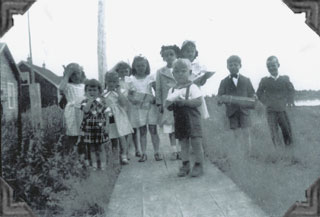
Jill with friends
Fun
and Games
The
children enjoyed having more friends to play with. During the winter,
when it was difficult to play outside, they invented games to play
indoors. One such game, inspired by their earlier trip outside to
visit Grandma in Ottawa, was to pretend that their small tricycles
were cars. The floor plan of the house was suitable for this game,
as it was possible to ride in a circle right around the ground floor,
through the kitchen, hall, and living room, as many times as they
wanted. One bright idea was to pretend they were getting gas for their
cars. The gas pump was the large soda-acid fire extinguisher in the
hall, and they duly attached its hose nozzle to the back of one of
the cars. Unfortunately, they forgot to remove it when they drove
off. The extinguisher fell over and immediately began to gush clouds
of foam. There was no way possible of turning it off once the chemical
reaction had begun. An urgent call for help brought Dick, who with
some effort managed to detach the inextinguishable extinguisher from
the tricycle and rush out of the house with it, still spraying and
spewing like mad. A couple of passers-by were intrigued - people usually
rush into a house with a fire extinguisher! In spite of much washing
and scrubbing I never did get the stains completely off the hall walls;
I resorted to hoping that it would be repainted in time for the next
occupants.
Permafrost
Some
things were very different indeed in Aklavik, particularly one that
was to affect the future of the town: the peculiarity of the soil
on which Aklavik was built. It was frozen solid, except for two months
in the summer, when it melted to a depth of six inches or so. As the
permafrost - the moisture in the soil - froze and melted in succeeding
cold and warm seasons, the surface of the earth would heave, and the
floors of the houses could not help but move up and down in sympathy.
Big jacks were installed in our basement; they were used to raise
or lower the joists above, helping us to cope with the problem of
uneven floorboards.
On
their regular visits, the Royal Canadian Corps of Engineers (RCCE)
inspectors used a simple but effective technique to test whether the
floors of the army buildings were level. They put a table-tennis ball
on the floor and watched which way it rolled. They could then decide
whether the jacks in the basement needed to be wound up or down to
level the floor. Eventually, after judicious winding, the ball did
become stationary. By the time the engineers next visited, the whole
process would invariably have to be repeated.
Another
addition to our basement furnishings was a sump pump. This was useful
when it was necessary to get rid of water seeping into the basement
from the melting permafrost.
These
perennial problems with the silt on which Aklavik was built led eventually
to its being replaced as the local centre of government. In the new
town of Inuvik, on the eastern side of the delta, it was possible
to compensate for the difficulties of permafrost. Inuvik's gain was
Aklavik's loss: the town now has a much smaller population, of only
about seven hundred.

All
Saints Cathedral, "The Cathedral of the Arctic," Aklavik.
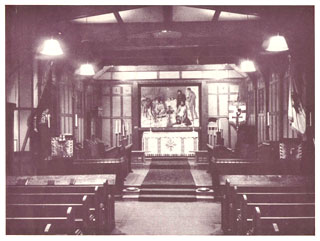
All
Saints Cathedral, interior.
All Saints Cathedral
An
architectural highlight of Aklavik in 1952 was All Saints Cathedral,
the Anglican "Cathedral of the Arctic." Built in 1939 to
replace the original 1919 building, it resembled a typical English
parish church. The interior contained a remarkable number of church
furnishings that had been sent from England as gifts. Many had some
historic value as well as being objects of beauty in themselves.
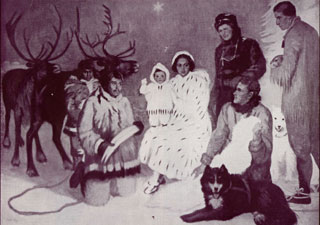
Epiphany
of the Snows, altarpiece in All Saints Cathedral.
Above
the altar hung a painting, Epiphany of the Snows, which seemed extremely
appropriate for a church in the far North. It was a nativity scene
painted by Violet Teague, an Australian artist. The Madonna, in a
long Inuit-style ermine parka and mukluks, holds the baby Jesus, in
ermine parka, pants, and mukluks, on her lap. Bringing gifts to the
Child are, not middle Eastern magi and shepherds, but northerners.
On the left, a Nascopie-Cree from the Ungava Peninsula presents a
live beaver, a Hudson's Bay Company factor offers white fox pelts,
and a Royal Canadian Mounted policeman in dark furs represents protection.
An Inuit in a caribou-skin parka, bearskin trousers, and sealskin
boots offers two walrus tusks, and behind him stands an Inuit woman
from Baffin Island, with a baby in the hood of her caribou-skin parka,
her gift not visible. Two sled dogs, a malamute and a husky, and two
reindeer are present instead of the usual sheep, cattle, or camels.
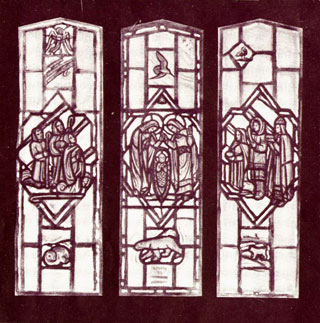
Baptistery
windows, All Saints Cathedral.
The
three colourful stained glass windows in the baptistery were donated
by Inuit members of the congregation. The left one, with a seal in
its lower portion, was given by Susie Wolkie in memory of her husband,
Fred. The middle window, given by Fred Carpenter in memory of his
wife, Lucy, shows a polar bear, and the one on the right, donated
by Charlie Smith in memory of his wife, Lily Sarniak, pictures the
three wise men, one dressed as an Inuit, with a sled dog below.
During our time in Aklavik, Canon Colin Montgomery, brother of Field
Marshal Bernard ("Monty") Montgomery, was the priest responsible
for the Anglican mission and the Cathedral. It is sad to say that
this church, with its fascinating display of adapted and adopted northern
elements, was destroyed by fire in 1972. I do not know whether any
of the contents survived its destruction.
Posting
Our
posting to Aklavik was a completely new experience. Living in the
real land of the midnight sun was wonderful. Unfortunately, our stay
there did not last very long. In January of 1953, six months after
our arrival, Dick was promoted and posted. In keeping with the army's
gypsy way of life, we were soon on our way.
This
time it was south to "fresh fields and pastures new," to
what was to be a new experience, for me although not for Dick: life
in an army camp. Camp Shilo, on the prairies of Manitoba, would reveal
yet another aspect of Canada - although not quite as different from
"ordinary" life as our unique and fascinating northern postings
had been.
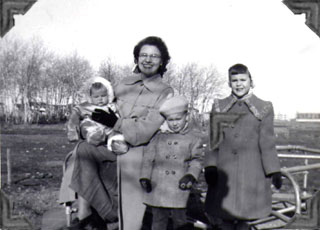
Camp
Shilo, Manitoba, 1953: Ian, Jean, Chris, and Jill.
[Next
Page]
Pages: [1]
[2] [3]
[4] [5]
[6] [7]
[8] [9] [10]
[11] [12]
[13] [14]
[15] [16]
Return to top of
page
Return to the Watts
Family page